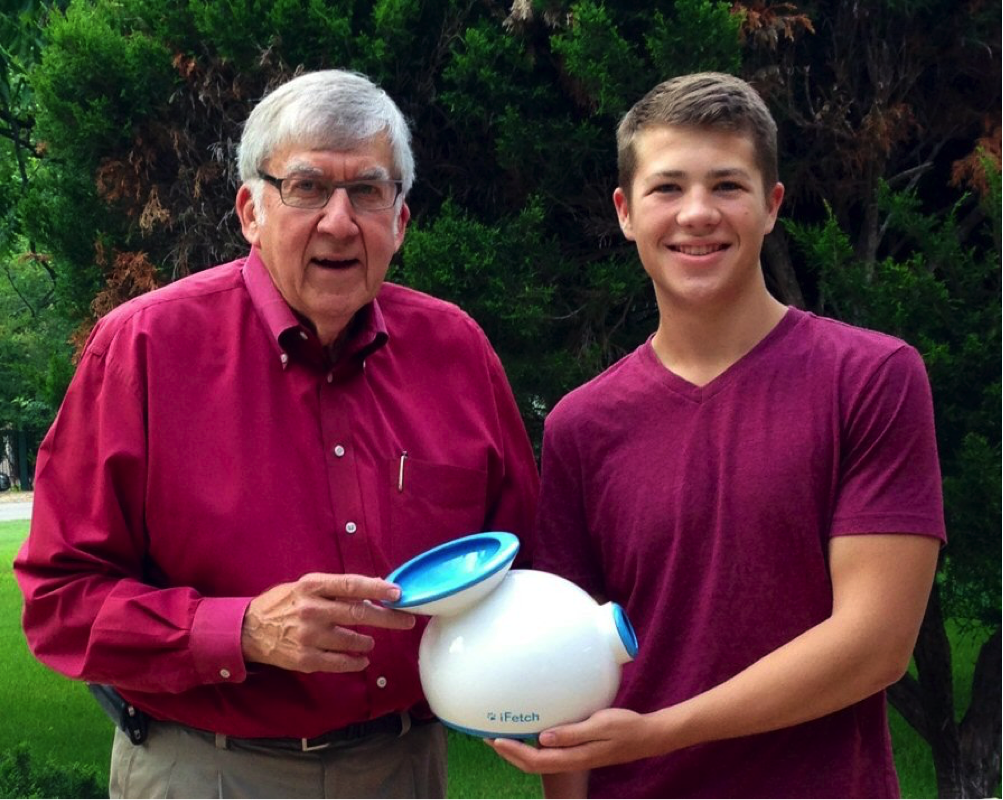Keep it in the family: How an energetic poodle inspired Denny Hamill and his grandson to create and patent a problem-solving invention

iFetch is a revolutionary invention that solves a problem that many know all too well: You come home from work or school, run errands, cook, and attend to other obligations. The family dog, who despite going on a brisk walk a couple hours earlier, is just brimming with energy. Unfortunately, you are not. What’s the solution? Denny Hamill and his grandson, Grant, took matters into their own hands. Read our interview with Denny to learn more about how this product came to life and how patents played a pivotal role in its development.
Save The Inventor: Please tell us a little bit about yourself, about iFetch, and your history leading up to your idea for iFetch.
Denny: I am a physicist turned marketer and worked for a large company for 30 years managing their business in electronics markets, totaling over 1 billion dollars in annual global sales. I retired and spent 10 years advising small, high-tech startup companies in Austin, not imagining that I would start one myself.
“Why don’t we build something that will throw the ball for Prancer so I can get my work done?” – Grant Hamill
STI: What was the spark that led to the idea of iFetch?
D: The family has a small poodle, Prancer, who is a fetch fanatic. He loves to play fetch and constantly pesters all family members to throw the ball for him. My grandson, Grant Hamill, was trying to do his homework (at the time a sophomore in high school) and Prancer kept dropping the ball at his feet and barking, “please throw the ball.” Grant finally asked “Why don’t we build something that will throw the ball for Prancer, so I can get my work done?”
STI: When did you decide to make a go of iFetch and what indicators let you know that this was a viable product?
D: We researched and found there was no such ball launcher on the market. So, Grant and I built a rough prototype using the car accelerating wheels from a Hot Wheels set. It worked fine, and Prancer liked it, so we thought about how to go about actually developing a product. I had managed many new product commercialization teams in the past, so I knew what had to be done, but hadn’t yet really done it by myself.
“I knew how important it would be to protect this novel, new, interactive fetch toy…” – Denny Hamill
STI: When did you first realize that you needed to patent iFetch? Was there someone who guided you in this decision to protect your intellectual property?
D: I held patents from earlier involvements and know how important they are. In particular, I knew how important it would be to protect this novel, new, interactive fetch toy, it was clear that this concept of allowing a dog to get exercise and entertainment all by itself would be very valuable if protected.
STI: What does having a patent mean to you and your business?
D: Protecting our intellectual property with trademarks, design patents, utility patents and trade-dress registrations are critical in modest volume electro-mechanical products, which can be fairly easily copied. We are seeing such copies and are aggressively pursuing them around the world based on our IP portfolio.
STI: What patent-related or IP-related advice would you give other inventors and innovators based on your experience?
D: We started very early with good prior art searches, focused on both design and utility patents, filed in major countries around the world, and built a strong full portfolio. This importance has grown as the ability to sell globally online has made it easier for people to copy and sell products.
STI: What challenges have you faced as you developed iFetch both as the product and as a business?
D: We found an industrial design company to do the initial critical design, another company to do the design for manufacture, another company to do the manufacturing and a company near us in Austin to do the order handling and fulfillment. Finding the right partners was critical to our successful product launch and business growth.
STI: What advice would you give other inventors and innovators based on your experience?
D: Look for a real need not being satisfied (Grant’s need to get homework done and still keep Prancer happy). Build an effective team by finding the best examples of core competencies that you need. Find an effective way to validate your solution; we used crowd funding through Kickstarter to validate the iFetch concept before tooling for manufacture. Pay attention to feedback from early customers to most effectively accelerate acceptance and growth.
STI: What’s next for iFetch?
D: We have launched two new products in the last six months and are working on a number of others. We have expanded globally with importers/distributors in over 20 countries. As people around the world are treating their dogs as members of the family, and are truly committed to providing the best lives for them, we are focused on building a broad line of products to fight both boredom and obesity with interactive products that provide both exercise and entertainment. Physical and mental stimulation is our value offering for dogs and their families.
Learn more about iFetch by visiting their website at goifetch.com.
Did you like this story? Check out our spotlight on Joe Nafziger and Ben Larson, inventors of Readydesk.
If you’re an inventor and would like to tell us your story, please go here. You may end up with your own feature right here on our blog.
